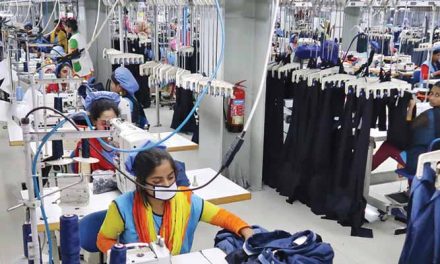 India’s goods exports are falling while service exports are performing well. This has helped reduce the overall trade. Deficit among merchandise exports ready-made garments is among those which have registered a decline in November 2023. Over the preceding month. Sluggish global demand is attributed for the decline. It is not therefore surprising that all textile exporting countries to the US have reported a negative growth both in respect of apparel and total textiles and apparel in January – October 2023 over the same period of 2022, data compiled by US Textile Department shows.
India’s goods exports are falling while service exports are performing well. This has helped reduce the overall trade. Deficit among merchandise exports ready-made garments is among those which have registered a decline in November 2023. Over the preceding month. Sluggish global demand is attributed for the decline. It is not therefore surprising that all textile exporting countries to the US have reported a negative growth both in respect of apparel and total textiles and apparel in January – October 2023 over the same period of 2022, data compiled by US Textile Department shows.
As per the data, India’s apparel exports fell to $5014 mn from $5687 mn during the period under review China’s exports dropped to $14177 mn from $19344 mn. Vietnam which has much more infra structure facilities than India reported a sharp decline from $16040 mn to $12223 mn. Exports from Bangladesh, a least developed country (LDC) could export $6356 mn worth apparel against $8447 mn.
Sri Lanka’s exports decreased from $1839 mn to $1393 mn, while those of Pakistan fell from $2397 mn to $1721 mn. Perhaps this is for the first time that these countries have exhibited a decline in their exports to the US. Even countries such as Honduras, Mexico and El-Salvador – which have agreements with the US allowing them duty-free-entry – have also fared poorly, recording a negative growth. Earlier, these countries had been enjoying quota– free entry as well in the US, but the system was ended in 2004. The data reveals that total imports of apparel and textiles into the US, that is exports by all countries including India, came down sharply from $87,030 mn to $67,262 mn pointing to the bad market conditions in that country.
As for total textiles and apparel exports, the data shows that Indian supplies fell from $9667 mn to $7713 mn. China’s exports came down from $28787 mn to 21590 mn. Vietnam’s exports dropped from $17244 mn to $13175 mn, while those of Bangladesh declined from $8712 mn to $6512 mn. As in the case of apparel exports, Honduras, El Salvador and Mexico have reported negative growths respectively in respect of total textiles and apparel, the data shows.
Union Commerce Ministry seems optimistic. Its Secretary Sunil Bharthwal says that “given the global situation, India’s export numbers are healthy despite the general global slowdown, interest rate regime not softening and global conflict. India has done extremely well he asserts.
He further says that his Ministry has drawn comfort from the combined trade numbers, which includes both goods and services. Latest data showed that in November, service exports went up by 6.6 percent to $2.87 bn, while imports fell 13 percent to $13.4 bn, resulting in a trade surplus of $15.3 bn, helping narrow the overall trade deficit to $5.3 bn.
Exports and analysts say that the services trade surplus has raised incrementally for six months now, providing a significant buffer to the goods trade defect. FIEO President A. Sakthivel attributes the export decline to several factors. These include rising uncertainties slow global economic recovery and demand and the proposed easy and low cost credit marketing support, in addition to interest equalisation to all sectors.
Now compare the performance in 2022 with 2021. The data shows that China’s apparel exports rose from $19590 mn to $21751 mn. India’s exports also increased from 4190 mn to $5687 mn, those of Vietnam from 14342 mn to $18242 mn and of Sri Lanka from 1730 mn to $2125 mn. Exports from Honduras, El Salvador and Mexico also enhanced their performance.
It needs no mention, that the US again is an important destination for India’s textiles and apparel exports. India is the third largest supplier of these products to the US, after China and Vietnam. But the US appears not keen on a Free Trade Agreement (FTA) as proposed by India. According to a study by FCCI and Wazir Advisors, the FTA will majorly improve its share in the US of apparel imports. From a value of 5.8 percent, it could increase to as high as 20 percent by 2025. India’s share in US imports of textiles will also increase substantially in segments of yarn and fabrics.
The current global apparel market is worth $1.7 trillion and constitutes two percent of GDP. EU – 28 and China are the largest apparel markets with a combined share of about 54 percent. The global apparel market is expected to touch $2.6 trillion by 2025 with a projected rate of 4 percent. The major growth drivers of the global market will be the developing countries, mainly China and India, both growths in double digits. China will become the biggest apparel market, adding more than $378 bn in market size by 2025.
These two countries with a large growing demand will lead to a combined addition of around $500 bn in the global apparel market by 2025. The combined apparel market size of China and India, that is $795 bn, is expected to exceed the combined size of the EU and the US, that is $775 bn by 2025. In the US, our textiles products attract duties ranging from 13 percent to 32 percent, though the average tariffs range between 15 percent and 16 percent
Trade experts and former negotiators explain that every WTO member maintains high tariffs on certain products to protect farmers and to promote manufacturing. India is no different, referring to Korea’s 800 on some products such as sweet potatoes and cereals.
India’s officials refer to the “World Tariff Profiles 2018” which lists some of the highest tariff by countries where India at 150 percent is eclipsed by Japan at 736 percent. South Korea at 807 percent and the US at 150 percent. The trade weighted average at MFN applied tariff for India at 7.6 percent is moderate compared to Korea and Brazil, among others. Officials point to India’s development imperative, the importance of balancing imports with its own manufacturing capacity.
As is known, EU and US are the largest markets for textiles and apparel with a share of 36 percent and 14 percent respectively. On the supply side, China is the largest supplier of these products in the world with a dominating share of 40 percent. It is distantly followed by countries like India, Italy and Germany with an approximate share of 5 percent in the global textiles and apparel exports.
The FICCI – Wazir advisers further notes that the textile industry has witnessed a major shift in the last three decades in terms of production till the 1980’s. Production of textiles and apparel was centered in the US and EU. Over a period of time, production of these items got shifted to Asian Countries.




















